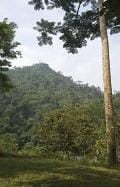As the international conference on climate change in late 2010 in Cancún, Mexico, reached a disappointing outcome, we will have to resort to doing our own bit to protect our environment. This includes taking care of trees and forests, because forest clearance and degradation accounts for close to 20% of the annual emissions of greenhouse gases. Quite apart from all the other losses caused by the destruction of forest – indigenous people’s homes and livelihoods, biodiversity, soil protection, and countless more – this link to our atmosphere is increasingly seen as crucial. So what is being done about it?
REDD
No, I have not misspelt the colour ‘red’! This acronym stands for ‘Reduced Emissions from Deforestation and Degradation’ and is a UN-backed initiative to tackle the continuing problem of the loss of forest, particularly in the tropics. It is not cheap but does represent a concerted attempt, region by region, to try to get to grips with an incredibly complex problem. One difficulty, as always, is definition: what is a ‘degraded’ forest, and hence eligible to receive money to support reforestation? There is some debate about how REDD should be funded – with options ranging from carbon trading, a special fund or a mixture between the two, and debate on this subject is fierce. (Carbon trading allows countries and companies that are producing below their quota of carbon dioxide to sell their remaining allowance as credit to other countries and companies that have not kept to their own quotas.)
In recent times the initiative has been enlarged to REDD-plus which aims to reduce emissions from deforestation and forest degradation and to support the role of conservation, sustainable management of forests and improvement in the amount of carbon held in forests in developing countries. There are some concerns that despite sounding like a positive development, REDD-plus could impact on the rights of indigenous peoples in forests, and potentially lead to the conversion of some forests to industrial tree plantations with implications for biodiversity.
Planted forests
The concept of planted forests (see box) is an important one because the UN’s Food and Agriculture Organization (FAO) has assembled some surprising data. In 2005, when the FAO collected data about planted forests using this wider definition, planted forests were found to account for about 280 million hectares or some 7% in area of the world’s forests. The surprise was that this small proportion in area was supplying a large percentage of the world’s wood products: in a few years’ time some 70% of the world’s forest products will be coming from just 7% of its forests.
This conclusion has far-reaching implications. It means that at last wood production is following the path of agriculture and is focused on intensive management of relatively few forests. More importantly, it means that the world’s great natural forests do not need to be logged by companies to make wood products, though they may be destroyed for other reasons.
Back to climate change
Deforestation contributes to greenhouse gas emissions, so what about tree planting to soak up carbon? This attractive idea is less straightforward than it seems. Certainly over their lifetime trees store or capture carbon, but we need to look very carefully at whether other aspects of management undo the good. For example, if the cultivation of the soil before planting releases lots of carbon dioxide (as organic matter decays) or if expensive protection is needed, the carbon balance – as it is called – may not be so positive. However, if wood and timber from planted forests can be used more widely, and even in place of energy-rich materials such as steel, aluminium and cement where appropriate, then reductions can be achieved.
The world’s forests are a precious gift from God. Let’s care for them wisely and remember even God himself delights in beholding trees (Genesis 2:9)!
Julian Evans has authored 12 books, including Plantation Forestry in the Tropics. He edited and partly authored a book for the Food and Agriculture Organization of the United Nations, Planted Forests – uses, impacts and sustainability, published in 2009. He is vice-president of the Commonwealth Forestry Association and was on Tearfund’s Board for 19 years.
Planted forests
A category of forests called ‘planted forests’ includes:
- tree plantations
- native forests which have been regenerated by tree planting
- forms of agroforestry (growing trees with livestock or arable crops)
- planting in and around homes and villages for fuel wood, building poles, fencing materials etc.










